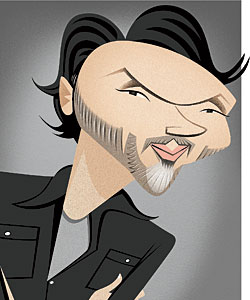
The play follows a recently paroled drug dealer as he learns of his girlfriend’s infidelity. What attracted you to it?
I’m a big fan of [playwright] Stephen Guirgis. He’s a poet on so many levels, and he has this ear for modern urban parlance.
Your character, the parole officer Ralph, turns out to be extremely flawed.
It’s one of the things that keep drawing me back to the theatre. The actor’s journey is to continue to show versatility. I’m going to stretch out many different kinds of muscles dealing with Ralph and what addiction and loyalty and sobriety are all about in his skewed interpretation of them.
Have you come to any conclusions about the character?
He has used the whole landscape of what sobriety is, in terms of this 12-step program, to his own advantages. In many ways, it’s control [of parolees]. He gets to feel good about himself. That’s where things get really skewed. You can draw parallels to any kind of religious cult, that kind of power, when you’re helping people who are very vulnerable.
There’s a lot of outlandish humor in the play, and you’ve mostly done drama (in TV shows LA. Law, NYPD Blue, and The West Wing, for example). Does comedy pose different challenges?
It’s not slapstick kind of comedy. It’s not timing of jokes. The humor comes from the audience seeing all the characters’ foibles.
There’s also a vicious fight scene. How did you prepare for that?
I can tell you [director] Anna Shapiro and I have talked about the physicality of that fight, which is brutal in a lot of ways. They’re bringing in a fight coordinator to make it [realistic]. The last thing you want is for the audience to be taken out of the play.
The characters in the play are Puerto Rican, but they’re also addicts and criminals. Do you have any reservations about the portrayal of Hispanics?
I don’t think of it as Latino life. The question of addiction is more far-reaching. What fascinates me about Guirgis, who is not Hispanic, is that he can deal with this question of addiction and give voice to the same hopes that anybody has—the hopes to find love, to get a better job.
How do you plan to spend your time while in town?
On Mondays [when the show is dark], you’ll find me at a museum. You’ve got some of the greatest museums in the country—Science and Industry, all of the art museums. The city has so much to offer. I haven’t looked at my schedule yet, but I hope there’s a Monday night Bulls game so I can see my buddy Derrick Rose.
You were here years ago to film Running Scared in winter. Now you’re back at the same time. What’s up with that?
When you say “wind” in Chicago cavalierly like you do, come on. Man, do you guys get serious wind. The movie was night shoots and exteriors. This time, it won’t be exteriors. I’m going to be in the warm embryo of Steppenwolf.
Have you seen other Steppenwolf productions?
I’ve seen the stuff they’ve brought to New York. The memories of Balm in Gilead and Grapes of Wrath are emblazoned in my brain. I was reminded when I saw Good People at Steppenwolf in October how much heart that company has. I’m ecstatic to be there.
GO The Motherfucker with the Hat runs through Mar. 3 at Steppenwolf Theatre. For info, steppenwolf.org.
Illustration: Robert Risko


